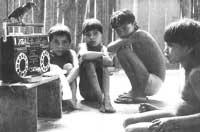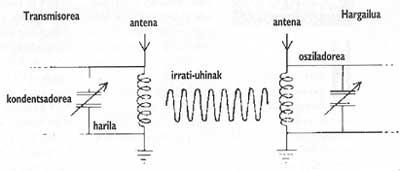Broadcasting
Science and technology advance step by step and their influence on our daily lives is evident. Even the home or car radio apparatus that remains on for many hours, does not offer us songs and locutions from nowhere.
Heinrich Hertz first achieved radio broadcasting in 1886. The message he could transmit to a few centimeters was nothing more than the energy released in the form of a spark in a cable.
In 1897 Marconi got the radio signals to be broadcast to a boat located 29 km. Years later they started using wireless radio on ships.
The first radio devices were connected to telegraphic devices that received the signals on paper. The most important element in the following stations was the detector. The best known detector was formed by a magnetite or silicon crystal and a winding. This detector called Galena was used until the invention of the thermoion valve. The latter, for its low price and comfort, remained until the appearance of the transistor.
The first voice broadcasts were made in Germany and the United States, but none of them worried.
From 1919, radio fans abandoned telegraphy. In fact, the triode invented by Forest Americano (electronic tube or valve with three electrodes) served to transmit, detect or amplify signals and thanks to this invention a new industry was created: that of radio stations.
Although progress is important, the first radio transmission of the 1920s and the quality and complexity of radio equipment is not comparable to the multiple current resources. In addition to the very weak signal to the first appliances in the house, the old appliances had little sensitivity.

Therefore, the antenna had to be located ten meters from the ground and well isolated. However, only enough power was obtained to hear from the headphones. The first speakers, for their part, had more power than allowed to listen to a radio show in case the people in a room were silenced. In 1920 Rice and Kellogg invented the mobile coil speaker in the United States, a design that has remained virtually unchanged to date.
After a brief history, we will explain what happens so that when you turn on the radio apparatus we can hear the radio program.
Radio communication is done by so-called hertzian or electromagnetic waves. Each hertzian wave has its own characteristics and according to its frequency several types are distinguished: short, medium, long waves and VHF (very high frequency). Therefore, each radio station will have a certain frequency band depending on the type of wave you use. Knowing what is the support for sending the message, we will show in particular the path that the words of the radio announcer follow to reach the radio apparatus of our home.
To start the speaker's word, the microphone picks it up and turns it into an electric signal. Subsequently this signal must be modulated, since being at the lower frequency, it must be placed so that it can be sent. This signal is called a wave or modulating signal. The radio station has in its transmitter an apparatus called an oscillator that produces a carrier wave. This carrier wave is in high frequency, that is, its frequency is equal to the channel of the radio station.
When modular, the modulating signal modifies one of the characteristics of the carrier wave (amplitude, frequency or phase of the wave) and transmits the carrier wave, signal or modulated wave that has been modified. That is why we search the radio apparatus for the characteristics called AM (amplitude modulation), FM (frequency modulation) and PM (phase modulation).
The modulated electromagnetic wave transmission can be terrestrial (from the radio station antenna to the apparatus antenna) and satellite (from the satellite to our antenna). When we tune the radio device with the frequency of this radio station the modulated signal emitted from the air will arrive. Once this step is reached, the process is completed upside down.
The modulated signal is dismodulated, i.e., the high-frequency carrier wave is removed and the low-frequency electrical signal is stopped. As in the broadcast, the signal that arrives weakly is reinforced by the amplifier. The last step is to convert the electrical signal into sound through the speakers. And at the end of this process, we can tune the radio and listen to what the announcer has said before the microphone.






